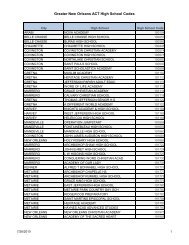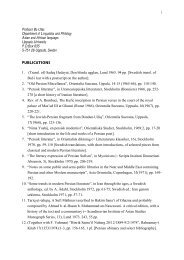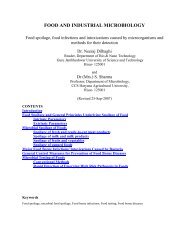Vesicles and Pustules in the Newborn
Vesicles and Pustules in the Newborn
Vesicles and Pustules in the Newborn
You also want an ePaper? Increase the reach of your titles
YUMPU automatically turns print PDFs into web optimized ePapers that Google loves.
<strong>Vesicles</strong> <strong>and</strong> <strong>Pustules</strong><br />
<strong>in</strong> <strong>the</strong><br />
<strong>Newborn</strong><br />
Julian Trev<strong>in</strong>o, M.D.<br />
Associate Professor<br />
Boonshoft School of Medic<strong>in</strong>e<br />
Department of Dermatology<br />
Vesiculobullous Diseases<br />
Non-Infectious Etiology<br />
Ery<strong>the</strong>ma toxicum neonatorum<br />
Transient neonatal pustular melanosis<br />
Miliaria crystall<strong>in</strong>a <strong>and</strong> rubra<br />
Acropustulosis of <strong>in</strong>fancy<br />
Neonatal cephalic pustulosis (neonatal “acne”)<br />
Eos<strong>in</strong>ophilic pustular folliculits<br />
Incont<strong>in</strong>entia pigmenti<br />
Neonatal herpes gestationis<br />
Neonatal pemphigus<br />
Epidermolysis bullosa<br />
Congenital self self-heal<strong>in</strong>g heal<strong>in</strong>g reticulohistiocytosis<br />
Ery<strong>the</strong>ma toxicum neonatorum<br />
INCIDENCE<br />
20 20-60% 60% of term <strong>in</strong>fants<br />
Less Less frequently <strong>in</strong> preterm neonates ~5%<br />
<strong>Vesicles</strong> <strong>and</strong> <strong>Pustules</strong> <strong>in</strong> <strong>the</strong><br />
<strong>Newborn</strong><br />
Represent Represent wide spectrum of disorders<br />
Several conditions present<strong>in</strong>g with <strong>the</strong>se f<strong>in</strong>d<strong>in</strong>gs are truly life-<br />
threaten<strong>in</strong>g<br />
Many conditions with <strong>the</strong>se f<strong>in</strong>d<strong>in</strong>gs are <strong>in</strong>nocuous <strong>and</strong> self self-limited limited<br />
All All newborns <strong>and</strong> <strong>in</strong>fants with vesicles <strong>and</strong><br />
pustules should be evaluated with:<br />
Thorough history <strong>and</strong> physical exam<br />
Appropriate laboratory evaluation(s)<br />
Vesiculobullous Diseases<br />
Infectious Etiology<br />
Scabies Scabies<br />
Neonatal Neonatal c<strong>and</strong>idiasis<br />
Staphylococcal Staphylococcal scalded sk<strong>in</strong> syndrome<br />
Herpes Herpes simplex<br />
Congenital Congenital varicella<br />
Congenital Congenital syphilis<br />
Ery<strong>the</strong>ma toxicum neonatorum<br />
DESCRIPTION<br />
Types of lesions: ery<strong>the</strong>matous macules, wheals, papules<br />
<strong>and</strong> pustules<br />
Sites of predilection - face, trunk, proximal arms <strong>and</strong><br />
buttocks<br />
Palms Palms <strong>and</strong> soles almost never affected (due to lack of<br />
pilosebaceous units)
Ery<strong>the</strong>ma toxicum neonatorum Ery<strong>the</strong>ma toxicum neonatorum<br />
Ery<strong>the</strong>ma toxicum neonatorum<br />
COURSE<br />
Most Most beg<strong>in</strong> dur<strong>in</strong>g second 24 hours of life<br />
Rarely present at birth<br />
May May beg<strong>in</strong> any time from birth to 2 weeks<br />
Exacerbations Exacerbations <strong>and</strong> remissions occur dur<strong>in</strong>g first<br />
few weeks of life<br />
Ery<strong>the</strong>ma toxicum neonatorum<br />
PROGNOSIS <strong>and</strong> TREATMENT<br />
Self Self-limit<strong>in</strong>g limit<strong>in</strong>g<br />
Requires Requires no treatment<br />
Reassure Reassure parents as to benign/non<strong>in</strong>fectious<br />
nature of condition<br />
Unknown Unknown<br />
ETIOLOGY<br />
Has been postulated to be hypersensitivity reaction based on<br />
eos<strong>in</strong>ophilic response<br />
Ery<strong>the</strong>ma toxicum neonatorum<br />
DIAGNOSIS<br />
Usually based on cl<strong>in</strong>ical appearance of <strong>the</strong> rash<br />
<strong>in</strong> an o<strong>the</strong>rwise healthy healthy term term <strong>in</strong>fant<br />
<strong>in</strong>fant<br />
Atypical cases:<br />
Scrap<strong>in</strong>g of pustules sta<strong>in</strong>ed with Wright’s sta<strong>in</strong> demonstrate<br />
large number of eos<strong>in</strong>ophils<br />
Peripheral eos<strong>in</strong>ophilia <strong>in</strong> 15% of cases<br />
Transient Neonatal Pustular Melanosis (TNPM)<br />
INCIDENCE<br />
2 2 to 5% of term black newborns<br />
0.6% 0.6% of term Caucasian newborns<br />
Equal Equal numbers of boys <strong>and</strong> girls affected
TNPM<br />
DESCRIPTION<br />
<strong>Pustules</strong> or pigmented macules, with/without a<br />
surround<strong>in</strong>g di collarette ll tt of f scale l present t s<strong>in</strong>gly i l or <strong>in</strong> i<br />
comb<strong>in</strong>ation<br />
Located on forehead, ch<strong>in</strong>, neck, back, h<strong>and</strong>s <strong>and</strong><br />
feet, <strong>in</strong>clud<strong>in</strong>g palms <strong>and</strong> soles<br />
TNPM<br />
Unknown Unknown<br />
TNPM<br />
ETIOLOGY<br />
DIAGNOSIS<br />
Usually made cl<strong>in</strong>ically based on lesion morphology,<br />
time time of of onset, onset <strong>and</strong> <strong>and</strong> absence absence of of o<strong>the</strong>r o<strong>the</strong>r f<strong>in</strong>d<strong>in</strong>gs<br />
f<strong>in</strong>d<strong>in</strong>gs<br />
Gram sta<strong>in</strong> - demonstrates neutrophils, rare<br />
eos<strong>in</strong>ophils <strong>and</strong> absence of bacteria<br />
Wright <strong>and</strong> Giemsa sta<strong>in</strong> - demonstrates<br />
neutrophils <strong>and</strong> rare eos<strong>in</strong>ophils<br />
TNPM<br />
TNPM<br />
COURSE<br />
Lesions present at birth <strong>and</strong> progress to a brownish crust<br />
or rupture l leav<strong>in</strong>g i a fi f<strong>in</strong>e white hi collarette ll of f scale l<br />
Found <strong>in</strong> clusters or <strong>in</strong>dividually<br />
New lesions usually do not appear after birth<br />
Resolves <strong>in</strong> 24 to 48 hours<br />
TNPM<br />
PROGNOSIS <strong>and</strong> TREATMENT<br />
Sk<strong>in</strong> Sk<strong>in</strong> f<strong>in</strong>d<strong>in</strong>gs are not correlated with maternal<br />
<strong>in</strong>fection or neonatal <strong>in</strong>fection<br />
Prognosis Prognosis is excellent with self self-resolution; resolution;<br />
however, hyperpigmented macules may last for<br />
several weeks to months before resolv<strong>in</strong>g<br />
Treatment Treatment is non non-essential essential
Miliaria<br />
INCIDENCE<br />
A common dermatosis of <strong>the</strong> neonate <strong>and</strong> <strong>in</strong>fant<br />
In warm climates, may be present <strong>in</strong> up to 15% of<br />
newborns<br />
Two types of miliaria occur <strong>in</strong> <strong>the</strong> newborn period -- --<br />
milaria rubra (‘prickly heat”) <strong>and</strong> crystall<strong>in</strong>a; miliaria rubra<br />
is <strong>the</strong> most frequently seen<br />
Equal among sexes <strong>and</strong> races<br />
Miliaria<br />
Miliaria Miliaria<br />
Miliaria<br />
COURSE<br />
Miliaria Miliaria crystall<strong>in</strong>a is occasionally present at birth<br />
Mili Miliaria Mili Miliaria i rubra b more common after f first fi week k of f life lif<br />
DESCRIPTION<br />
<strong>Vesicles</strong>, pustules or papules <strong>in</strong> crops<br />
Occurs on <strong>the</strong> face, trunk <strong>and</strong> <strong>in</strong>terig<strong>in</strong>ous areas<br />
Usually presents <strong>in</strong> term <strong>and</strong> pre pre-term term neonates greater<br />
than ten days old<br />
Infrequently miliaria crystall<strong>in</strong>a presents at birth;<br />
miliaria rubra more common after first week of life<br />
ETIOLOGY<br />
Follows excessive warm<strong>in</strong>g <strong>in</strong> <strong>in</strong>cubator, fever,<br />
occlusive l i dress<strong>in</strong>gs, d i or i <strong>in</strong>appropriately i l warm cloth<strong>in</strong>g l hi<br />
Obstruction of <strong>the</strong> eccr<strong>in</strong>e duct, followed by leakage<br />
of <strong>the</strong> eccr<strong>in</strong>e sweat <strong>in</strong>to <strong>the</strong> sk<strong>in</strong><br />
Extracellular polysaccharide produced by some stra<strong>in</strong>s<br />
of Staph epidermidis may obstruct sweat delivery<br />
Miliaria<br />
DIAGNOSIS<br />
Usually based on lesion location, time of onset, <strong>and</strong><br />
history of excessive warm<strong>in</strong>g<br />
In cases where diagnosis is uncerta<strong>in</strong> a sk<strong>in</strong> biopsy can<br />
be performed
Miliaria<br />
PROGNOSIS <strong>and</strong> TREATMENT<br />
Resolves spontaneously, but may have recurrences with<br />
rubra<br />
The lesions resolve <strong>in</strong> 1 to 3 days with shedd<strong>in</strong>g of<br />
kerat<strong>in</strong>ous plugs<br />
Treatment <strong>in</strong>volves cool baths <strong>and</strong> removal of excess<br />
cloth<strong>in</strong>g<br />
Acropustulosis of <strong>in</strong>fancy<br />
DESCRIPTION<br />
Intensely pruritic vesicles <strong>and</strong>/or pustules on palms<br />
<strong>and</strong> soles, dorsa of h<strong>and</strong>s <strong>and</strong> feet, sides of f<strong>in</strong>gers g<br />
<strong>and</strong> toes, ankles, wrists, <strong>and</strong> occasionally <strong>the</strong> chest,<br />
back, <strong>and</strong> abdomen<br />
More common form occurs follow<strong>in</strong>g scabies<br />
<strong>in</strong>festation<br />
Usually follows scabies that has been severe or prolonged<br />
<strong>in</strong> duration<br />
Acropustulosis of <strong>in</strong>fancy<br />
Unknown Unknown<br />
ETIOLOGY<br />
Acropustulosis of Infancy<br />
INCIDENCE<br />
Seen <strong>in</strong> less than 1% of newborns<br />
I Increased di <strong>in</strong> Af African African-American i A AAmerican i males l<br />
Association with atopy <strong>in</strong> some patients <strong>and</strong> families<br />
Acropustulosis of <strong>in</strong>fancy<br />
Acropustulosis of <strong>in</strong>fancy<br />
COURSE<br />
Lesions Lesions may be present at birth, but more often<br />
d develop l i <strong>in</strong> <strong>the</strong> h fi first weeks k or months h of f life lif<br />
The The lesions appear <strong>in</strong> crops every 2 to 4 weeks;<br />
<strong>in</strong>dividual lesions last 55-10<br />
10 days; course may last<br />
1-2 2 years
Acropustulosis of <strong>in</strong>fancy<br />
DIAGNOSIS<br />
Must differentiate from scabies<br />
Gi Giemsa, W Wright i h <strong>and</strong> d G Gram sta<strong>in</strong>s i<br />
Reveal numerous neutrophils, <strong>and</strong> occasional eos<strong>in</strong>ophils<br />
Bacteria, scabies mites/eggs/feces are absent<br />
KOH - negative for hyphae<br />
Neonatal cephalic pustulosis (neonatal “acne”)<br />
INCIDENCE<br />
May May be seen <strong>in</strong> up to 20% of newborns<br />
Acropustulosis of <strong>in</strong>fancy<br />
PROGNOSIS <strong>and</strong> TREATMENT<br />
Usually remits spontaneously with<strong>in</strong> 1 to 2 years<br />
Symptomatic treatment <strong>in</strong>cludes ld systemic<br />
antihistam<strong>in</strong>es <strong>and</strong> potent topical steroids<br />
Severe disease may be treated with Dapsone 1-2 1 2<br />
mg/kg/day (requires laboratory evaluation for G-6- G<br />
PD deficiency <strong>and</strong> frequent monitor<strong>in</strong>g)<br />
Neonatal cephalic pustulosis<br />
DESCRIPTION<br />
Papulopsutular Papulopsutular facial eruption usually<br />
concentrated on cheeks; also may <strong>in</strong>volve<br />
forehead, ch<strong>in</strong>, eyelids, neck, upper chest<br />
<strong>and</strong> scalp<br />
Comedones Comedones are absent<br />
Neonatal cephalic pustulosis Neonatal cephalic pustulosis<br />
ETIOLOGY<br />
Likely related to stimulation of sebaceous gl<strong>and</strong>s by<br />
maternal <strong>and</strong>rogens <strong>and</strong>rogens or or transient transient adrenal adrenal <strong>and</strong> <strong>and</strong> gonadal<br />
gonadal<br />
<strong>and</strong>rogen production<br />
Several authors have proposed Malassezia furfur <strong>and</strong> M.<br />
sympoidalis as causes of this condition
Neonatal cephalic pustulosis<br />
COURSE<br />
May May be present at birth<br />
Mean Mean age of onset is 22-3<br />
3 weeks<br />
Condition Condition remits spontaneously after several<br />
weeks<br />
Neonatal cephalic pustulosis<br />
TREATMENT<br />
Topical Topical imidazole creams (e.g.,<br />
ketoconazole)<br />
k kketoconazole) l )<br />
Low Low-potency potency topical steroids<br />
Condition Condition remits spontaneously after<br />
several weeks<br />
Incont<strong>in</strong>entia Pigmenti<br />
Four Four Stages<br />
DESCRIPTION<br />
Vesicular - ery<strong>the</strong>matous macules, papules, vesicles <strong>and</strong> bullae<br />
<strong>in</strong> a l<strong>in</strong>ear arrangement follow<strong>in</strong>g <strong>the</strong> l<strong>in</strong>es of Blaschko on extremities,<br />
trunk <strong>and</strong> scalp<br />
Verrucous - streaks of hyperkeratotic papules <strong>and</strong> pustules<br />
Hyperpigmentation - hyperpigmented macules <strong>and</strong> patches along<br />
Blaschko’s l<strong>in</strong>es<br />
Hypopigmentation - hypopigmentation of previously<br />
hyperpigmented areas,with or without follicular atrophy<br />
Neonatal cephalic pustulosis<br />
DIAGNOSIS<br />
Usually Usually made on cl<strong>in</strong>ical presentation<br />
Giemsa Giemsa-sta<strong>in</strong>ed sta<strong>in</strong>ed smears demonstrate fungal spores<br />
as well as neutrophils<br />
Incont<strong>in</strong>entia Pigmenti<br />
INCIDENCE<br />
Over Over 700 cases reported<br />
97% 97% females due to XX-l<strong>in</strong>ked<br />
l<strong>in</strong>ked dom<strong>in</strong>ant<br />
<strong>in</strong>heritance<br />
Incont<strong>in</strong>entia Pigmenti- vesicular stage
Incont<strong>in</strong>entia Pigmenti- hyperpigmented stage Incont<strong>in</strong>entia Pigmenti- hypopigmented stage<br />
Incont<strong>in</strong>entia Pigmenti<br />
ADDITIONAL FINDINGS<br />
Hair - scarr<strong>in</strong>g alopecia <strong>in</strong> 30%<br />
Nails - dystrophic dystrophic changes changes <strong>in</strong> <strong>in</strong> 5 5 to to 10 10 %<br />
%<br />
Teeth - anodontia, peg/conical teeth <strong>in</strong> 66%<br />
Eyes - strabismus, cataracts, optic atrophy, ret<strong>in</strong>al vascular<br />
changes <strong>and</strong> retrolental mass <strong>in</strong> 25 to 35 %<br />
CNS - seizures, mental retardation <strong>and</strong> spastic paralysis <strong>in</strong><br />
30%<br />
Hair<br />
Nails<br />
Teeth<br />
Eyes<br />
CNS<br />
Incont<strong>in</strong>entia Pigmenti<br />
ETIOLOGY<br />
X-l<strong>in</strong>ked l<strong>in</strong>ked dom<strong>in</strong>ant genodermatosis localized to<br />
gene l locus Xp11.21 X 11 21 or possibly ibl <strong>the</strong> h Xq28 X 28 region i<br />
NEMO NEMO gene (NFKB essential modulator) defect<br />
Incont<strong>in</strong>entia Pigmenti<br />
Incont<strong>in</strong>entia Pigmenti<br />
COURSE<br />
Sk<strong>in</strong> Sk<strong>in</strong> lesions present at birth <strong>in</strong> 50%; occur with<strong>in</strong> 2<br />
weeks <strong>in</strong> <strong>in</strong> 90% 90% of of cases<br />
cases<br />
Vesicular Vesicular - birth to 2 weeks<br />
Verrucous Verrucous - 2 to 6 weeks<br />
Hyperpigmentation<br />
Hyperpigmentation - 3 to 6 months<br />
Hypopigmentation<br />
Hypopigmentation - 2nd to 3rd decades
Incont<strong>in</strong>entia Pigmenti<br />
DIAGNOSIS<br />
Cl<strong>in</strong>ical Cl<strong>in</strong>ical <strong>and</strong> histologic correlation<br />
Detailed Detailed family history <strong>and</strong> complete sk<strong>in</strong> exam of<br />
mo<strong>the</strong>r <strong>and</strong> female sibl<strong>in</strong>gs<br />
Incont<strong>in</strong>entia Pigmenti<br />
PROGNOSIS <strong>and</strong> TREATMENT<br />
Normal life span<br />
C Complete l physical h i l exam<br />
Ophthalmology exam upon diagnosis<br />
Dental exam by 1 year<br />
Neurology exam upon diagnosis<br />
Genetic counsel<strong>in</strong>g for family

















